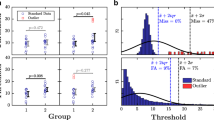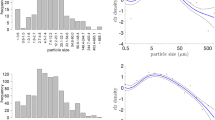Abstract
Multiple-point statistics (MPS) is a simulation technique allowing to generate images that reproduce the spatial features present in a training image (TI). MPS algorithms consist in sequentially filling a simulation grid such that patterns around the simulated values come from the TI. Following this principle, joint simulations of multiple variables can be handled and complex heterogeneous fields can be generated. However, inconsistent patterns are often found in the results and some spatial features can be difficult to reproduce. In this paper, a new MPS algorithm based on a multi-resolution representation of the TI is proposed to enhance the quality of the realizations. The method consists in first building a pyramid of images from the TI by successive convolution using Gaussian-like kernels. Secondly, a MPS simulation is done at the lowest resolution level. Then, the result is expanded to the next level of resolution (one rank higher) and used as a conditioning variable for a joint MPS simulation at that level. This last step is repeated up to the initial resolution, where the final simulation is retrieved. The method is implemented in the DeeSse code based on the direct sampling algorithm. Most of the features provided by the direct sampling (conditioning to hard data, uni- or multi-variate simulation of categorical and continuous variables, scaling and rotation of the training structures) are compatible with the proposed method and the usability is maintained. Finally, various examples show that in most of the situations, combining Gaussian pyramids with MPS allows to get results of better quality and in less time compared to direct MPS simulations.























Similar content being viewed by others
References
Arpat G, Caers J (2007) Conditional simulation with patterns. Math Geol 39(2):177–203. https://doi.org/10.1007/s11004-006-9075-3
Brooks S, Dodgson N (2002) Self-similarity based texture editing. ACM Trans Graph 21(3):653–656. https://doi.org/10.1145/566654.566632
Burt P, Adelson E (1983) The laplacian pyramid as a compact image code. IEEE Trans Commun 31(4):532–540. https://doi.org/10.1109/TCOM.1983.1095851
Gardet C, Le Ravalec M, Gloaguen E (2016) Pattern-based conditional simulation with a raster path: a few techniques to make it more efficient. Stoch Environ Res Risk Assess 30(2):429–446. https://doi.org/10.1007/s00477-015-1207-1
Mahmud K, Mariethoz G, Caers J, Tahmasebi P, Baker A (2014) Simulation of Earth textures by conditional image quilting. Water Resour Res 50(4):3088–3107. https://doi.org/10.1002/2013WR015069
Mariethoz G, Renard P, Straubhaar J (2010) The Direct Sampling method to perform multiple-point geostatistical simulations. Water Resour Res 46:1–14. https://doi.org/10.1029/2008WR007621
Oriani F, Straubhaar J, Renard P, Mariethoz G (2014) Simulation of rainfall time series from different climatic regions using the direct sampling technique. Hydrol Earth Syst Sci 18(8):3015–3031. https://doi.org/10.5194/hess-18-3015-2014
Renard P, Allard D (2013) Connectivity metrics for subsurface flow and transport. Adv Water Resour 51:168–196. https://doi.org/10.1016/j.advwatres.2011.12.001(35th Year Anniversary Issue)
Rezaee H, Mariethoz G, Koneshloo M, Asghari O (2013) Multiple-point geostatistical simulation using the bunch-pasting direct sampling method. Comput Geosci 54:293–308. https://doi.org/10.1016/j.cageo.2013.01.020
Shahraeeni M (2019) Enhanced multiple-point statistical simulation with backtracking, forward checking and conflict-directed backjumping. Math Geosci 51(2):155–186. https://doi.org/10.1007/s11004-018-9761-y
Straubhaar J (2019) DeeSse user’s guide. The Centre for Hydrogeology and Geothermics (CHYN), University of Neuchâtel, Neuchâtel, Switzerland
Straubhaar J, Renard P, Mariethoz G, Froidevaux R, Besson O (2011) An improved parallel multiple-point algorithm using a list approach. Math Geosci 43(3):305–328. https://doi.org/10.1007/s11004-011-9328-7
Straubhaar J, Walgenwitz A, Renard P (2013) Parallel multiple-point statistics algorithm based on list and tree structures. Math Geosci 45(2):131–147. https://doi.org/10.1007/s11004-012-9437-y
Straubhaar J, Renard P, Mariethoz G, Chugunova T, Biver P (2019) Fast and interactive editing tools for spatial models. Math Geosci 51(1):109–125. https://doi.org/10.1007/s11004-018-9766-6
Strebelle S (2002) Conditional simulation of complex geological structures using multiple-point statistics. Math Geol 34(1):1–21. https://doi.org/10.1023/A:1014009426274
Strebelle S, Remy N (2005) Post-processing of multiple-point geostatistical models to improve reproduction of training patterns. In: Leuangthong O, Deutsch C (eds) Geostatistics Banff 2004. Springer, Berlin, pp 979–988
Suzuki S, Strebelle S (2007) Real-time post-processing method to enhance multiple-point statistics simulation. In: Petroleum geostatistics. EAGE, Cascais, Portugal
Tahmasebi P, Hezarkhani A, Sahimi M (2012) Multiple-point geostatistical modeling based on the cross-correlation functions. Comput Geosci 16(3):779–797. https://doi.org/10.1007/s10596-012-9287-1
Zhang T, Switzer P, Journel A (2006) Filter-based classification of training image patterns for spatial simulation. Math Geol 38(1):63–80. https://doi.org/10.1007/s11004-005-9004-x
Acknowledgements
We are grateful to Loïc Mercerat who carried out a preliminary study helpful for this research. This work was supported partly by the Swiss National Science Foundation (Phenix project, grant number 200020_182600). We also thank Total S.A. for co-funding this work.
Author information
Authors and Affiliations
Corresponding author
Additional information
Publisher's Note
Springer Nature remains neutral with regard to jurisdictional claims in published maps and institutional affiliations.
Rights and permissions
About this article
Cite this article
Straubhaar, J., Renard, P. & Chugunova, T. Multiple-point statistics using multi-resolution images. Stoch Environ Res Risk Assess 34, 251–273 (2020). https://doi.org/10.1007/s00477-020-01770-8
Published:
Issue Date:
DOI: https://doi.org/10.1007/s00477-020-01770-8




